2000 SUBARU IMPREZA engine
[x] Cancel search: enginePage 188 of 320
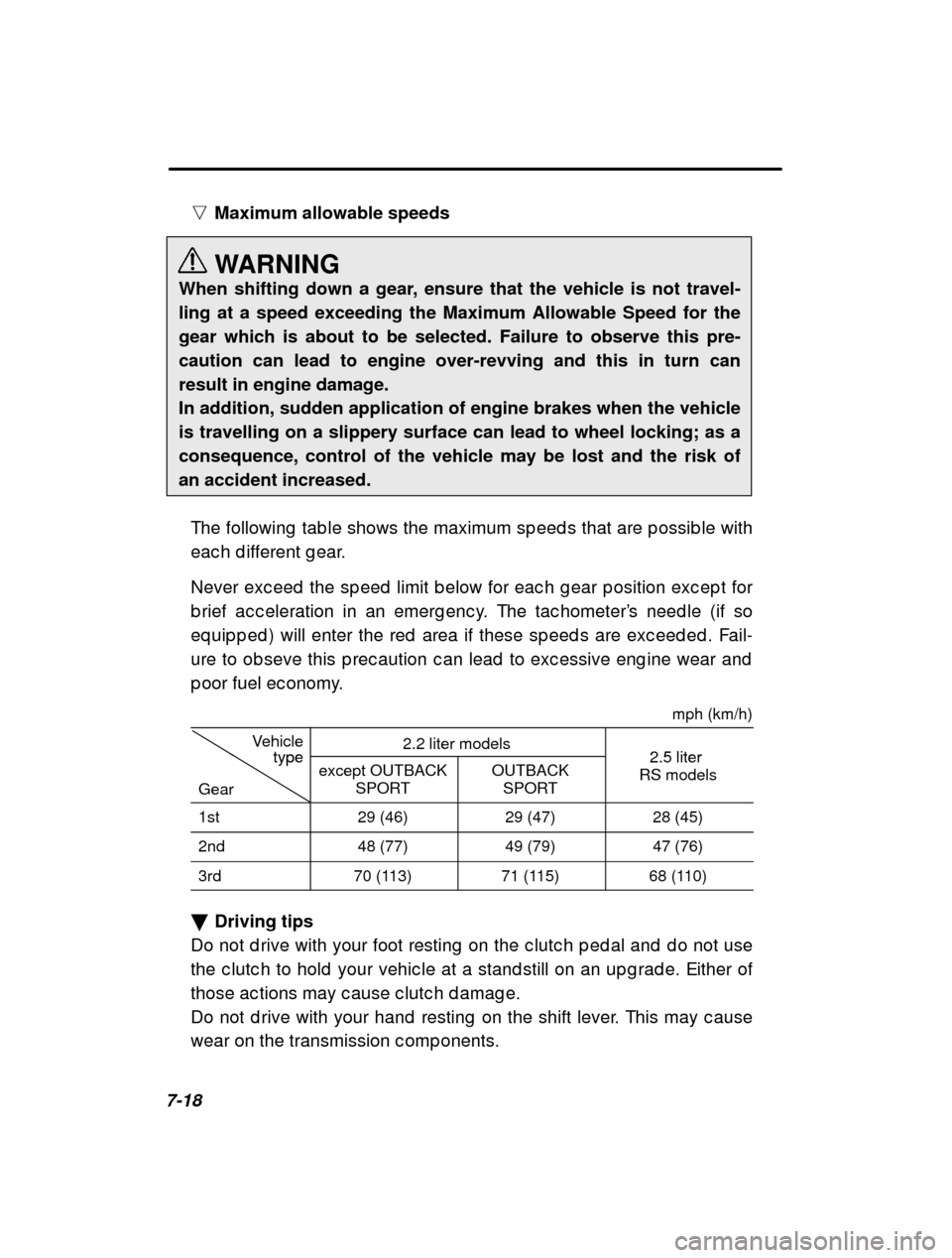
7-18n
Maximum allowable speeds
WARNING
When shifting down a gear, ensure that the vehicle is not travel- ling at a speed exceeding the Maximum Allowable Speed for thegear which is about to be selected. Failure to observe this pre-caution can lead to engine over-revving and this in turn canresult in engine damage.In addition, sudden application of engine brakes when the vehicleis travelling on a slippery surface can lead to wheel locking; as a
consequence, control of the vehicle may be lost and the risk ofan accident increased.
The following tab le shows the maximum sp eed s that a re p ossib le with
eac h d ifferent g ear.
Never exc eed the sp eed limit b elow for eac h g ear p o sition exc ep t for
b rief ac c eleration in an emerg enc y. The tac hometer ’s need le (if so
eq uip p ed ) will enter the red area if these sp eed s a re exc eed ed . Fail-
ure to ob seve this p rec aution c an lead to exc essive eng ine wear and
p oor fuel ec onomy.
mph (km/h)
Vehicle
type2.2 liter models2 5 litertype
Gear except OUTBACK
SPORTOUTBACKSPORT2.5 liter
RS models
1st29 (46)29 (47)28 (45)
2nd48 (77)49 (79)47 (76)
3rd70 (113)71 (115)68 (110)
� Driving tips
Do not d rive with your foot resting on the c lutc h p ed al and d o not use
the c lutc h to hold your vehic le at a stand still on an up g rad e. Either of
those ac tions may c ause c lutc h d amag e.
Do not d rive with your hand resting on the shift le ver. This may c ause
wear on the transmission c omp onents.
Page 189 of 320
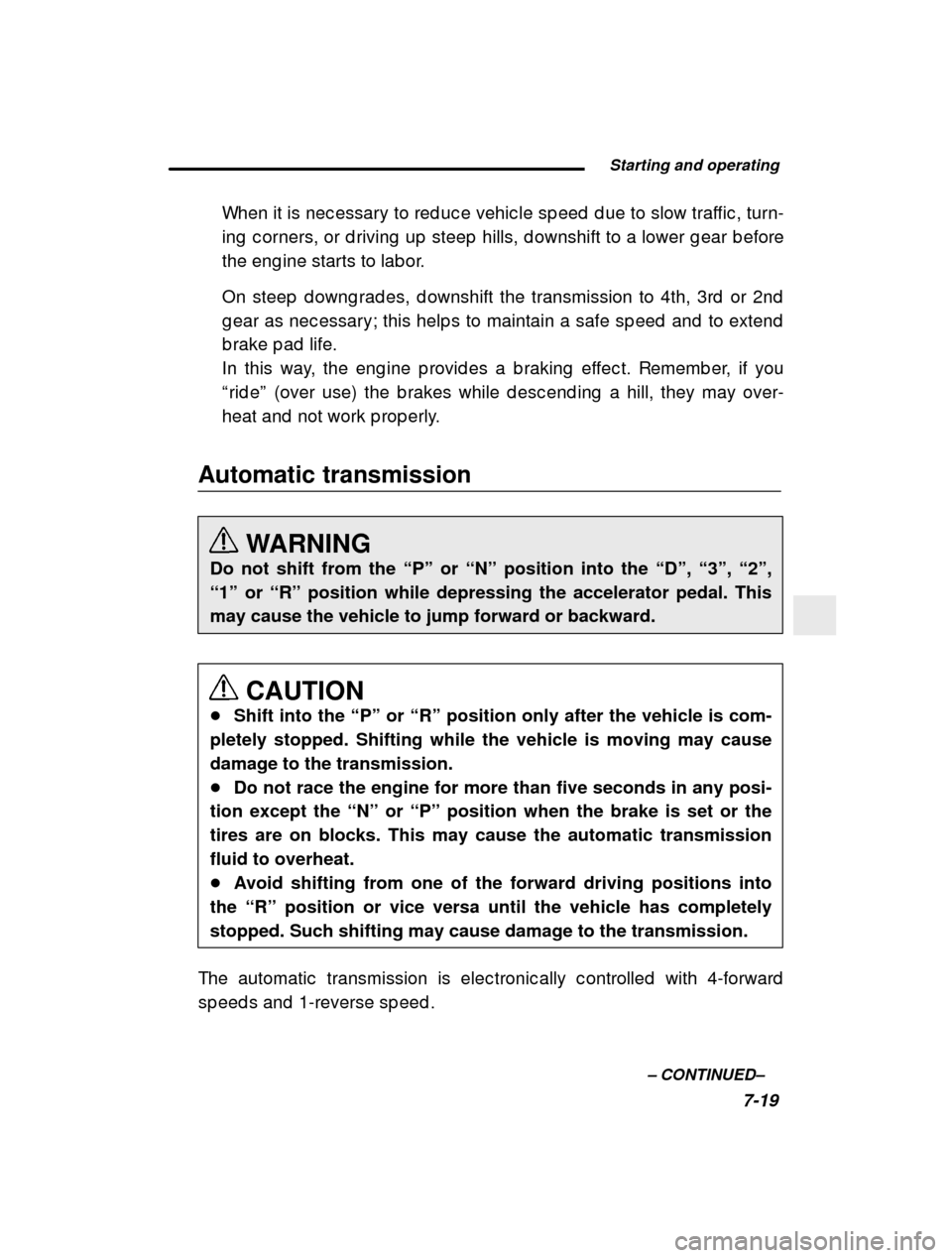
Starting and operating7-19
–
CONTINUED –
When it is nec essary to red uc e vehic le sp eed d ue to
slow traffic , turn-
ing c orners, or d riving up steep hills, d ownshift t o a lower g ear b efore
the eng ine starts to lab or.
On steep d owng rad es, d ownshift the transmission to 4th, 3rd or 2nd
g ear as nec essary; this help s to maintain a safe sp eed and to extend
b rake p ad life.
In this way, the eng ine p rovid es a b raking effec t. Rememb er, if you
“ rid e ” (over use) the b rakes while d esc end ing a hill, the y may over-
heat and not work p rop erly.
Automatic transmission
WARNING
Do not shift from the “P” or “N” position into the “D”, “3”, “2”,
“1” or “R” position while depressing the accelerator pedal. This
may cause the vehicle to jump forward or backward.
CAUTION
� Shift into the “P” or “R” position only after the vehicle is com-
pletely stopped. Shifting while the vehicle is moving may cause
damage to the transmission.� Do not race the engine for more than five seconds in any posi-
tion except the “N” or “P” position when the brake is set or the
tires are on blocks. This may cause the automatic transmissionfluid to overheat.� Avoid shifting from one of the forward driving positions into
the “R” position or vice versa until the vehicle has completely
stopped. Such shifting may cause damage to the transmission.
The automatic transmission is elec tronic ally c ontro lled with 4-forward
sp eed s and 1-reverse sp eed .
Page 191 of 320
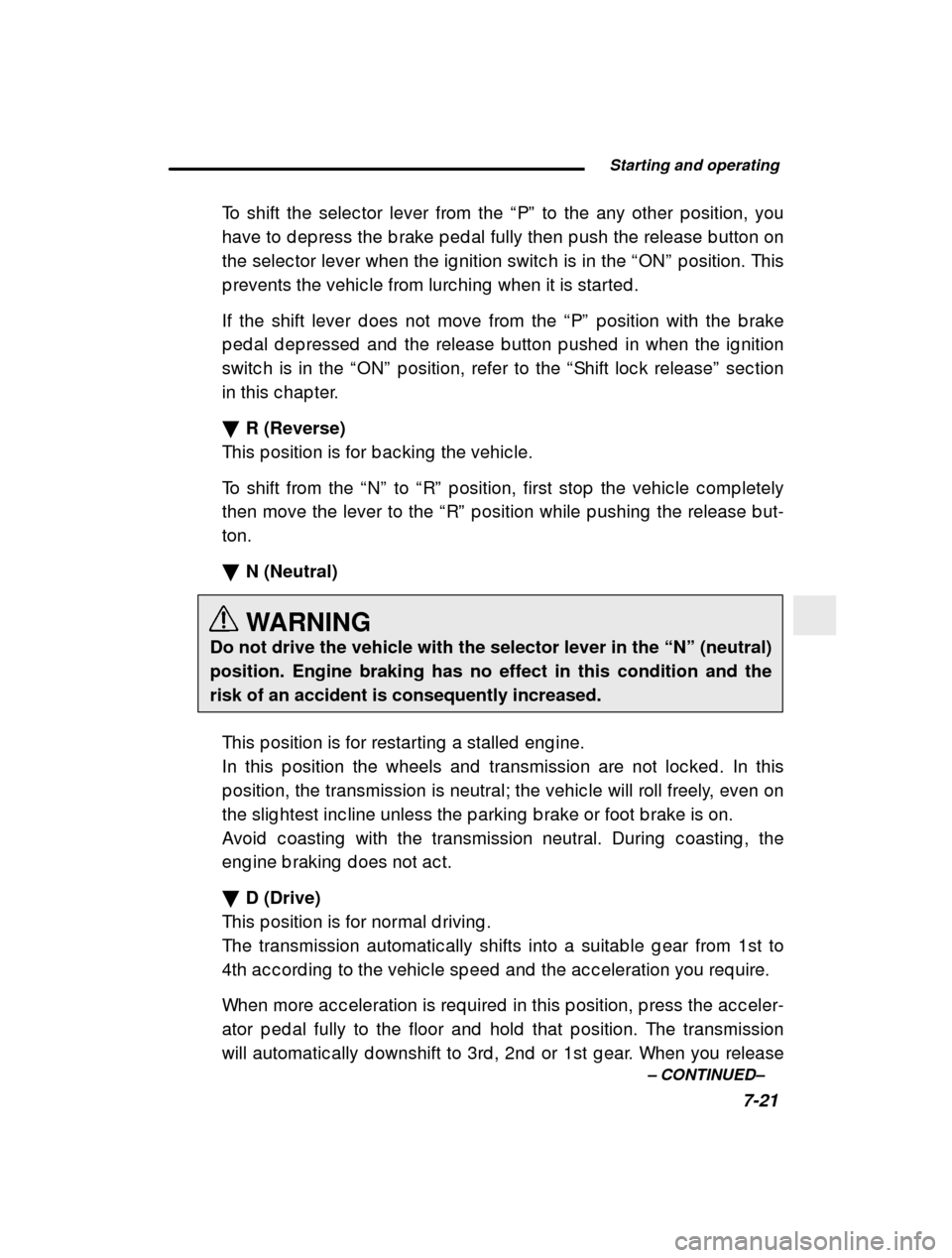
Starting and operating7-21
–
CONTINUED –
To shift the selec tor lever from the
“P ” to the any other p osition, you
have to d ep ress the b rake p ed al fully then p ush the release b utton on
the selec tor lever when the ig nition switc h is in t he “ON ” p osition. This
p revents the vehic le from lurc hing when it is start ed .
If the shift lever d oes not move from the “P ” p osition with the b rake
p ed al d ep ressed and the release b utton p ushed in wh en the ig nition
switc h is in the “ON ” p osition, refer to the “Shift loc k release ” sec tion
in this c hap ter. � R (Reverse)
This p osition is for b ac king the vehic le.
To shift from the “N ” to “R ” p osition, first stop the vehic le c omp letely
then move the lever to the “R ” p osition while p ushing the release b ut-
ton. � N (Neutral)
WARNING
Do not drive the vehicle with the selector lever in the “N” (neutral)
position. Engine braking has no effect in this condition and the risk of an accident is consequently increased.
This p osition is for restarting a stalled eng ine.
In this p osition the wheels and transmission are no t loc ked . In this
p osition, the transmission is neutral; the vehic le will roll freely, even on
the slig htest inc line unless the p arking b rake or f oot b rake is on.
Avoid c oasting with the transmission neutral. Durin g c oasting , the
eng ine b raking d oes not ac t. � D (Drive)
This p osition is for normal d riving .
The transmission automatic ally shifts into a suitab le g ear from 1st to
4th ac c ord ing to the vehic le sp eed and the ac c elera tion you req uire.
When more ac c eleration is req uired in this p osition , p ress the ac c eler-
ator p ed al fully to the floor and hold that p ositio n. The transmission
will automatic ally d ownshift to 3rd , 2nd or 1st g ea r. When you release
Page 192 of 320

7-22the p ed al, the transmission will return to the orig
inal g ear p osition.
n While climbing a grade
When d riving up a hill, und esired up shift to 4th g e ar is p revented from
taking p lac e when the ac c elerator is released . This minimizes the
c hanc e of sub seq uent d ownshifting to a lower g ear w hen ac c elerat-
ing ag ain. This p revents rep eated up shifting and d o wnshifting result-
ing in a smoother op eration of the vehic le. NOTE
The transmission may downshift to 2nd or 1st gear, depending on the way the accelerator pedal is pressed to accelerate the vehicleagain. n While going down a hill
When d esc end ing a steep hill, d ep ressing the b rake p ed al will c ause
the transmission to d ownshift to 3rd g ear, thus ap p lying eng ine b rak-
ing . Reac c eleration for a short time will c ause the transmission to up -
shift normally. NOTE In some cases, depressing the brake pedal on a downhill grade
does not result in an automatic downshift to 3rd gear. This canhappen when the automatic transmission fluid temperature is
very low, for example, during driving shortly after the vehicle has
been parked for an extended period of time. When the ATF tem-perature has risen to a certain level, automatic downshift normal-ly takes place. In the meantime, downshift manually for enginebraking as required.Also, downshifting when braking downhill will not occur at
speeds above approximately 50 mph (80 km/h). � 3 (Third)
This p osition is for using eng ine b raking when g oin g d own a hill or for
c limb ing a g rad e.
The transmission automatic ally shifts into a suitab le g ear from 1st to
3rd ac c ord ing to the vehic le sp eed and the ac c elera tion you req uire.
Page 193 of 320
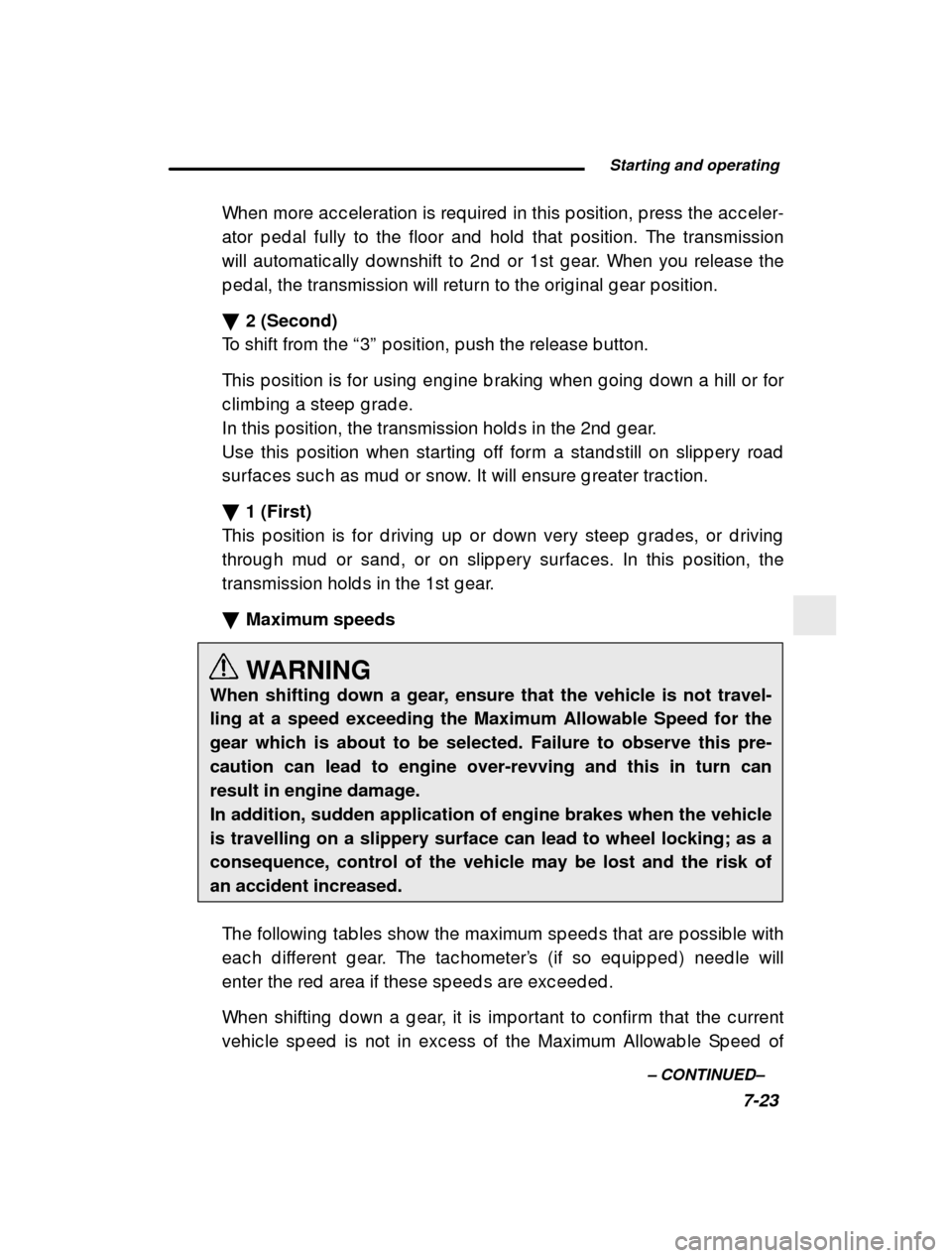
Starting and operating7-23
–
CONTINUED –
When more ac c eleration is req uired in this p osition
, p ress the ac c eler-
ator p ed al fully to the floor and hold that p ositio n. The transmission
will automatic ally d ownshift to 2nd or 1st g ear. Wh en you release the
p ed al, the transmission will return to the orig inal g ear p osition.
� 2 (Second)
To shift from the “3 ” p osition, p ush the release b utton.
This p osition is for using eng ine b raking when g oin g d own a hill or for
c limb ing a steep g rad e.
In this p osition, the transmission hold s in the 2nd g ear.
Use this p osition when starting off form a stand sti ll on slip p ery road
surfac es suc h as mud or snow. It will ensure g reate r trac tion.
� 1 (First)
This p osition is for d riving up or d own very steep g rad es, or d riving
throug h mud or sand , or on slip p ery surfac es. In th is p osition, the
transmission hold s in the 1st g ear. � Maximum speeds
WARNING
When shifting down a gear, ensure that the vehicle is not travel- ling at a speed exceeding the Maximum Allowable Speed for thegear which is about to be selected. Failure to observe this pre-caution can lead to engine over-revving and this in turn canresult in engine damage.In addition, sudden application of engine brakes when the vehicleis travelling on a slippery surface can lead to wheel locking; as a
consequence, control of the vehicle may be lost and the risk ofan accident increased.
The following tab les show the maximum sp eed s that a re p ossib le with
eac h d ifferent g ear. The tac hometer ’s (if so eq uip p ed ) need le will
enter the red area if these sp eed s are exc eed ed .
When shifting d own a g ear, it is imp ortant to c onfi rm that the c urrent
vehic le sp eed is not in exc ess of the Maximum Allow ab le Sp eed of
Page 196 of 320
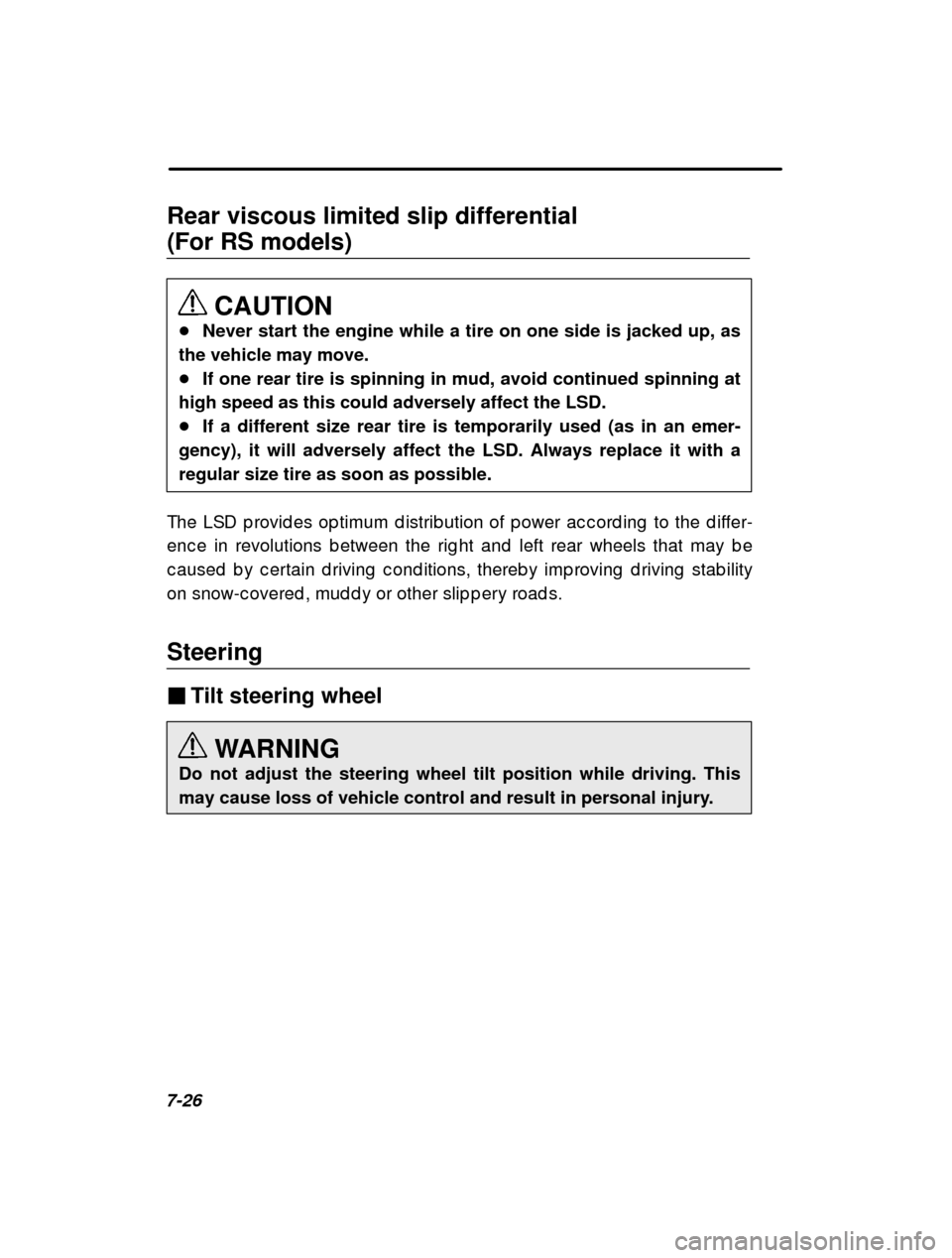
7-26Rear viscous limited slip differential (For RS models)
CAUTION
� Never start the engine while a tire on one side is jacked up, as
the vehicle may move. � If one rear tire is spinning in mud, avoid continued spinning at
high speed as this could adversely affect the LSD.� If a different size rear tire is temporarily used (as in an emer-
gency), it will adversely affect the LSD. Always replace it with aregular size tire as soon as possible.
The LSD p rovid es op timum d istrib ution of p ower ac c o rd ing to the d iffer-
enc e in revolutions b etween the rig ht and left rear wheels that may b e
c aused b y c ertain d riving c ond itions, thereb y imp ro ving d riving stab ility
on snow-c overed , mud d y or other slip p ery road s. Steering � Tilt steering wheel
WARNING
Do not adjust the steering wheel tilt position while driving. This
may cause loss of vehicle control and result in personal injury.
Page 200 of 320
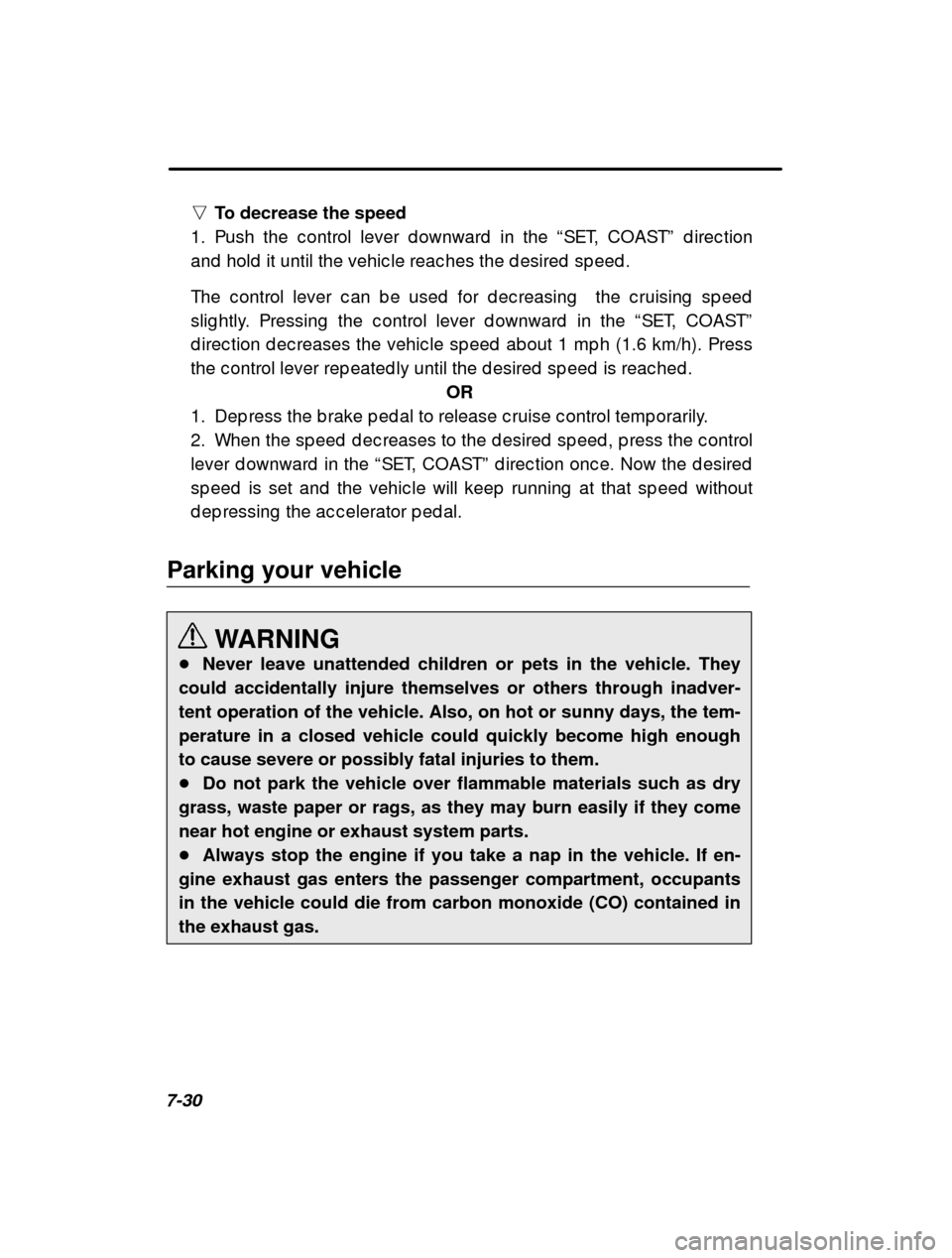
7-30n
To decrease the speed
1. Push the c ontrol lever d ownward in the “SET, COAST ” d irec tion
and hold it until the vehic le reac hes the d esired s p eed .
The c ontrol lever c an b e used for d ec reasing the c ruising sp eed
slig htly. Pressing the c ontrol lever d ownward in th e “SET, COAST ”
d irec tion d ec reases the vehic le sp eed ab out 1 mp h ( 1.6 km/h). Press
the c ontrol lever rep eated ly until the d esired sp ee d is reac hed .
OR
1. Dep ress the b rake p ed al to release c ruise c ontrol temp orarily.
2. When the sp eed d ec reases to the d esired sp eed , p r ess the c ontrol
lever d ownward in the “SET, COAST ” d irec tion onc e. Now the d esired
sp eed is set and the vehic le will keep running at t hat sp eed without
d ep ressing the ac c elerator p ed al.
Parking your vehicle
WARNING
� Never leave unattended children or pets in the vehicle. They
could accidentally injure themselves or others through inadver- tent operation of the vehicle. Also, on hot or sunny days, the tem-perature in a closed vehicle could quickly become high enoughto cause severe or possibly fatal injuries to them.� Do not park the vehicle over flammable materials such as dry
grass, waste paper or rags, as they may burn easily if they comenear hot engine or exhaust system parts.� Always stop the engine if you take a nap in the vehicle. If en-
gine exhaust gas enters the passenger compartment, occupantsin the vehicle could die from carbon monoxide (CO) contained inthe exhaust gas.
Page 202 of 320
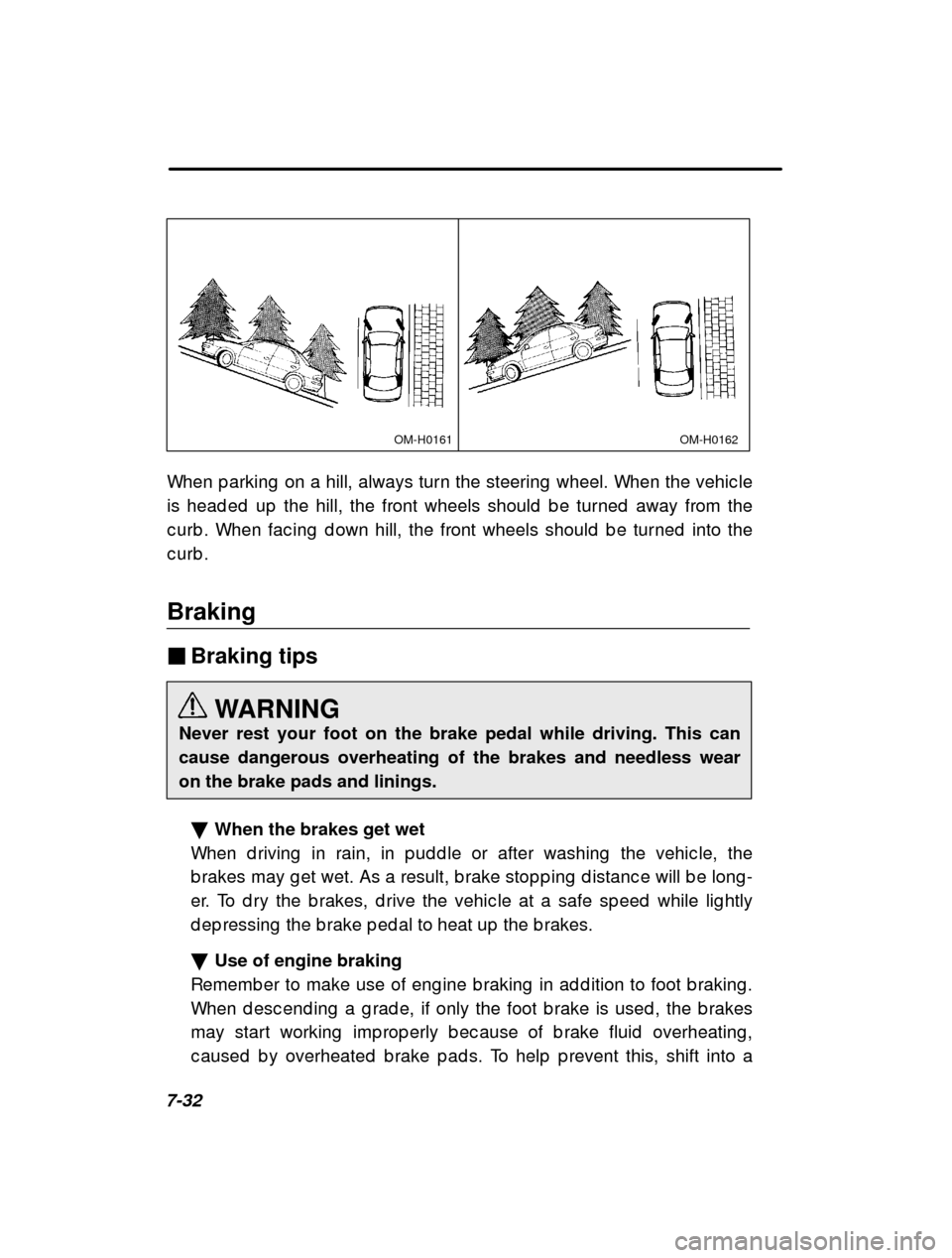
7-32
OM-H0162OM-H0161
When p arking on a hill, always turn the steering wh eel. When the vehic le
is head ed up the hill, the front wheels should b e t urned away from the
c urb . When fac ing d own hill, the front wheels shoul d b e turned into the
c urb . Braking � Braking tips
WARNING
Never rest your foot on the brake pedal while driving. This can
cause dangerous overheating of the brakes and needless wearon the brake pads and linings.
� When the brakes get wet
When d riving in rain, in p ud d le or after washing th e vehic le, the
b rakes may g et wet. As a result, b rake stop p ing d is tanc e will b e long -
er. To d ry the b rakes, d rive the vehic le at a safe sp eed while lig htly
d ep ressing the b rake p ed al to heat up the b rakes. � Use of engine braking
Rememb er to make use of eng ine b raking in ad d ition to foot b raking .
When d esc end ing a g rad e, if only the foot b rake is used , the b rakes
may start working imp rop erly b ec ause of b rake fluid overheating ,
c aused b y overheated b rake p ad s. To help p revent th is, shift into a